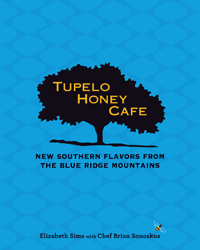This Is Not an Anthropology Lesson
Tupelo Honey Cafe pays delicious tribute to food—and life—in the Mountain South
When it comes to Southern food, you know you’re in trustworthy hands when a cookbook offers you five varieties of pimento cheese. And when you finally settle on a recipe and whip up a huge bowl of Sharp White Cheddar Pimento Cheese, you’re prepared to spend the next three days rummaging through your kitchen for breads, crackers, and other cheese-delivery devices because you know any Southerner who walks into your house will cling to the bowl as though magnetized. This is the real stuff.
 Tupelo Honey Cafe made a name for itself in Asheville, North Carolina, by bringing a spirit of adventure to a range of traditional Appalachian dishes. Now that Tupelo Honey has expanded throughout the region—including Tennessee locations in Knoxville, Chattanooga, and Johnson City—head chef Brian Sonoskus has partnered with writer Elizabeth Sims to create a collection of recipes and stories that reflect where the Mountain South’s culinary traditions came from and where they may be headed.
Tupelo Honey Cafe made a name for itself in Asheville, North Carolina, by bringing a spirit of adventure to a range of traditional Appalachian dishes. Now that Tupelo Honey has expanded throughout the region—including Tennessee locations in Knoxville, Chattanooga, and Johnson City—head chef Brian Sonoskus has partnered with writer Elizabeth Sims to create a collection of recipes and stories that reflect where the Mountain South’s culinary traditions came from and where they may be headed.
The Blue Ridge Parkway serves as a kind of narrative spine for these recipes and morsels of history. The structure works well for stories and sidebars of cultural context that never feel like an anthropology lesson. Wisely the authors avoid cutesy or sentimental portraits of the Appalachian past. Their recipes prove that these are living, breathing traditions.
If, like me, your regional origins and family history have already primed your taste buds to enjoy the dishes of the Mountain South, a casual glance through this book may quickly snowball into the biggest grocery list you’ve ever made. Every page contains a story, a combination of flavors, a lush illustration, or simply the name of a dish that may stir forgotten memories of family gatherings, church-basement suppers, and country diners. Among the evocatively-titled recipes I flagged for another day: The Pickled Okra (a moonshine cocktail), Dressed Up For Company Onion Casserole, and Acorn Squash Stuffed with Bacon Bread Pudding.
 There’s more good news if you don’t happen to be a professional chef. Unlike many cookbooks associated with restaurants, Tupelo Honey Cafe is designed for those who love food but don’t necessarily own a tricked-out industrial kitchen. Let me put it this way: I don’t have a cast-iron skillet, my broiler’s busted, and all my knives are dull, but none of that mattered. I still managed to prepare some of the best dishes my kitchen has yet seen. The recipes are written plainly, and they contain some give. The Blueberry Zinfandel Sauce (which I served over chicken, a pinch-hitter for the Guinea hen Sonoskus recommends) cooked at a much slower speed than was called for in the recipe, which affected the consistency of the finished sauce. But the velvety blend of blueberries, heavy cream, and red wine—not too heavy, not too sweet—could withstand some experimentation.
There’s more good news if you don’t happen to be a professional chef. Unlike many cookbooks associated with restaurants, Tupelo Honey Cafe is designed for those who love food but don’t necessarily own a tricked-out industrial kitchen. Let me put it this way: I don’t have a cast-iron skillet, my broiler’s busted, and all my knives are dull, but none of that mattered. I still managed to prepare some of the best dishes my kitchen has yet seen. The recipes are written plainly, and they contain some give. The Blueberry Zinfandel Sauce (which I served over chicken, a pinch-hitter for the Guinea hen Sonoskus recommends) cooked at a much slower speed than was called for in the recipe, which affected the consistency of the finished sauce. But the velvety blend of blueberries, heavy cream, and red wine—not too heavy, not too sweet—could withstand some experimentation.
Blueberry Zinfandel sauce is one of many small preparations sprinkled throughout the book as components of larger dishes—small, versatile marvels made from few ingredients. Goat Cheese Basil Grits, which the book presents as a tasty bed for Stroganoff Y’all, also stands alone as a potent, decadent breakfast. But the king of these little dishes must be Double Sausage Gravy, which is as thick and rich as it sounds. This gravy is designed to top a wonderful version of the classic Montreal dish, poutine. Tupelo Honey’s Southern Poutine is a mountain range of red potatoes, gravy, crumbled bacon, cheddar hoop cheese, and eggs sunny-side up.
Sims and Sonoskus have divided Tupelo Honey Cafe into thoughtful chapters that deepen the Blue Ridge Parkway metaphors. Perhaps the most poignant is a chapter titled “Native American Traditions and the Three Sisters.” With their Asheville home restaurant right in the heart of Cherokee country, the authors honor their region’s oldest culinary traditions as they describe the Cherokee intertwined method of growing the “three sisters”: corn, squash, and beans. Cultivated in a “symbiotic” arrangement, this planting pattern nourishes the soil while producing the region’s biggest staple crops. Sims describes the Three Sisters method as “a fascinating metaphor for living in the Mountain South, where interdependency, collaboration, and looking after your neighbor equal the means to a prosperous, satisfying life.” Of course this is a sanitized vision—the Cherokee were almost entirely ousted from the region by force—but the intent is an important one. The recipes that follow—Cornmeal-Fried Black-Eyed Peas, Gruyere and Sage Corn Casserole, and a glorious range of squash bakes—bear out the authors’ respect for native traditions and for the land itself.
The ingredient lists in Tupelo Honey Cafe reflect the extreme diversity of vegetation found throughout Appalachia, as well as the variety of game hunted there. But the authors have kindly made allowances for those of us who don’t have easy access to this cornucopia. No time to forage the hilltops for ramps? They’ll give you an alternative or two. One lovely feature of this cookbook is a series of grateful hat-tips to the local farms, gristmills, and dairies that supply Tupelo Honey with fresh ingredients. Still, there’s no local-foods-only snobbery here. The point is clear—whether you shop the farmer’s market or Piggly Wiggly, these cooking traditions deserve to live on in as many Southern kitchens as possible.
The flexibility built into the dishes reflects the inventive culture of the Mountain South itself, a fact that’s never lost on the authors. The book opens its delightful beverage chapter by invoking the resourcefulness of mountaintop drinkers. Whether they were making moonshine or pokeberry wine, they long ago accepted that “necessity is the mother of invention,” which is surely one reason why their stories continue to be passed on. To toast the ingenuity of the Mountain South, I recommend Ode to Muddy Pond—a satisfying blend of Maker’s Mark, fresh basil leaves, and good quality sorghum molasses.
Brian Sonoskus will discuss Tupelo Honey Cafe at Union Ave. Books in Knoxville on May 16, 2014, at 5 p.m.


